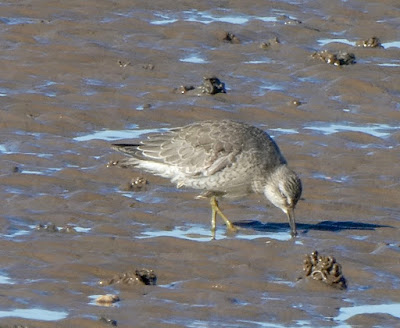Middleton Nature Reserve early morning - ringing (JR.PM)
Visible migration:
Swallow 3
Meadow Pipit 2
Siskin 2
Tree Pipit 2
Linnet 3
Snipe 3 on the ground.
Twelve birds ringed including 9 warbler (almost double figures - a Willow Warbler escaped)
Lesser Whitethroat 2
Common Whitethroat 2
Blackcap 2
Willow Warbler 3
Another Grey Wagtail was colour ringed
South Shore (MD)
Morning rising tide
Wheatear 1 on saltmarsh
I was giving it one more try from the mud in front of Ocean Edge. As I was walking out, this juvenile Peregrine was stood just where I was planning to stand.
I'm not sure if it was waiting to be fed, or already fending for itself.
Unsurprisingly, the bulk of the waders were much further south in front of Potts Corner. When the microlights started at 09:30, it was obviously time to call it a day and leave the beach to the holiday makers.
Wooden Jetty area - evening.
What a beautiful evening! Pleasantly warm, no breeze and surprisingly quiet.
Mediterranean gull - 12 adult feeding on the beach next to wooden jetty. Joined briefly by a juvenile.
The only darvic ringed bird today, was the regular German bird. The low sun making viewing difficult, but quite striking images.
Yesterday's white ringed bird was first ringed in Belgium as an adult - details:
Today's title refers to this handsome moth from Kevin's trap this morning.E948521
Ringed with white 3AH1 as Adult on 11/5/19 at the colony at Total, Antwerp, Belgium 51 15N 4 19E
Re-ringed with white 34ET on 12/5/20 at the Total colony. Presumably the original darvic was damaged.
Palpita vitrealis
 |
| It's a migrant from mainland Europe and mainly occurs in the South of the UK. It's quite rare this far North. |





















































